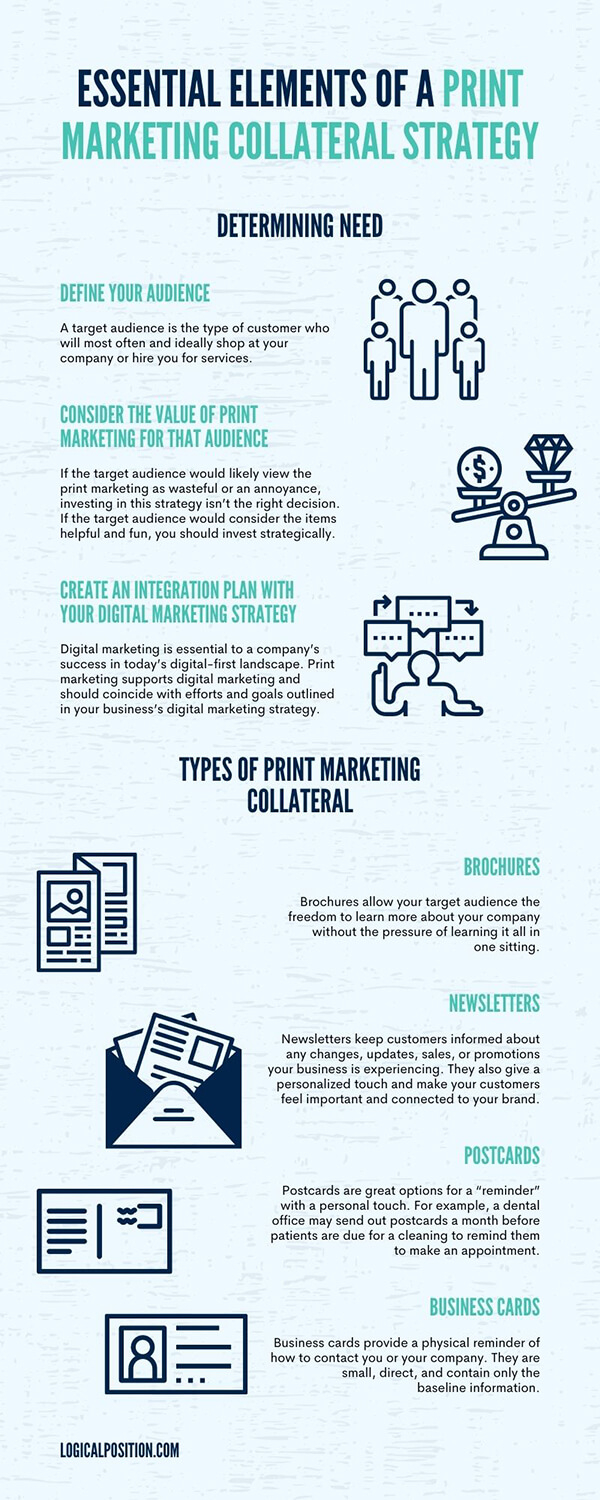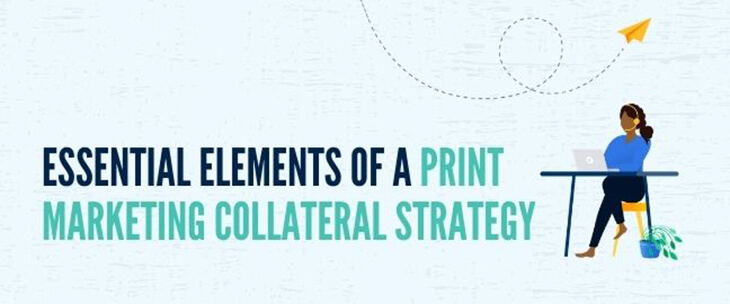Marketing comes in many forms. No matter the size or scale of a business, marketing is always necessary to encourage growth and upward mobility toward set goals. Every company operates with unique goals tailored to specific industries and clientele. How businesses reach or work toward goals also varies.
Digital marketing is all the rage right now as more businesses shift to an online-first platform. Digital marketing caters to the broadest and most diverse audience possible while offering the opportunity to connect on a deeper level with current and potential customers.
However, there is more to marketing than just digital platforms. Print marketing may be more beneficial now, in a digitally driven market, because of the personal touch and extra effort it illustrates. Coupled with a solid digital marketing strategy, print marketing can find great success. During implementation, make sure to focus on these essential elements of a print marketing collateral strategy.
Print Marketing Collateral: The Basics
Print marketing collateral refers to physical items that businesses provide to their customers for marketing purposes. These items could vary widely depending on industry and typically aim to inform, remind, and capture recurring demand.
Determining Need
Before a company invests in print marketing collateral, which can be expensive, start by determining a need. If the business’s target audience would not benefit from the items, there is no need to send them out.
Define Your Audience
The first step to determining a need for print marketing is to define your target audience clearly. A target audience is the type of customer who will most often and ideally shop at your company or hire you for services.
Consider the Value of Print Marketing for That Audience
Once you’ve identified your target audience, consider the impact print marketing would or would not make on that group of people. If the target audience would likely view the print marketing as wasteful or an annoyance, investing in this strategy isn’t the right decision. If the target audience would consider the items helpful and fun, you should invest strategically.
Create an Integration Plan With Your Digital Marketing Strategy
Just investing in print marketing is not enough to create demand with your target audience. Digital marketing is essential to a company’s success in today’s digital-first landscape. Print marketing supports digital marketing and should coincide with efforts and goals outlined in your business’s digital marketing strategy.
Types of Print Marketing Collateral
Print marketing collateral is an overarching term that can refer to many different items. After you’ve established the need and value of print marketing for your company and its goals, you must choose a type of print marketing collateral to invest in. The best choice dramatically varies based on each company’s target audience and objectives.
Brochures
Brochures are great options for when a company needs to provide a lot of information but wants to give their audience the flexibility to digest it on their own terms. Brochures allow your target audience the freedom to learn more about your company without the pressure of learning it all in one sitting.
Newsletters
While many companies send their newsletters out through email, sending out a physical copy can add a personal touch. Personalization helps newsletters stand out from other digital flyers cluttering your customers’ junk inbox. Newsletters should be short, simple, and have an attractive design.
Newsletters keep customers informed about any changes, updates, sales, or promotions your business is experiencing. They also give a personalized touch and make your customers feel important and connected to your brand.
Postcards
Postcards are great options for a “reminder” with a personal touch. For example, a dental office may send out postcards a month before patients are due for a cleaning to remind them to make an appointment.
Postcards can serve many purposes but should always include the following elements:
- A clear and concise call to action
- A phone number
- A website address
- The company’s name, logo, and tagline
Business Cards
Business cards provide a physical reminder of how to contact you or your company. They are small, direct, and contain only the baseline information. On a business card, provide only what data is necessary:
- Physical address (if your company has a brick-and-mortar location)
- Website
- A QR code to easily access the website
- Name and logo of the company
- Phone number

Ensuring Memorability and Personalization
You should always personalize print marketing materials for your customers. While nearly every company invests in digital marketing, print marketing shows your brand’s commitment to going above and beyond to connect with customers. Print collateral will quickly fall flat if the content isn’t audience focused.
Think Long Term
One of the advantages of investing in print collateral is its longevity. While customers may open an email once and then discard it, they can keep a brochure or newsletter and read it repeatedly. Make something that is relevant to your business and your customers longer-term.
Ensure Usability
Sending out items for the sake of sending them out won’t result in more word-of-mouth or stronger brand bonds. Your business must make its print collateral intentional. It should be something your customers will use and appreciate if you want it to yield results.
Customize To Fit Your Target Audience
Your print marketing should still be in line with your company’s branding efforts. This way, materials are both custom to your brand and personal for your audience. Just like you would with an email, include certain personalization elements to really connect with your audience:
- Customer’s name
- A personal message
- A call to action
- Ways to contact the company
Establishing Quality Guidelines
Quality is paramount when making printed items for customers. If your print items are low quality, they will end up in the trash. If these items act as an annoyance to your audience due to their quality, it can hurt your brand. Establishing a set standard for your collateral quality will help you find success with print material marketing.
Keep It Current
Outdated formats and fonts, low-quality graphics, and cheesy taglines are very early-2000s. Commit to making your print marketing stand out and stay current. Invest in high-quality graphic content that is visually appealing and can compete with the graphics people see all the time online.
Hold a High Standard
Your graphics and ad copy should be just as well-made as, if not superior to, what you use in your digital marketing campaign. Many customers aren’t used to seeing print marketing anymore, so they expect outstanding quality when they get some in the mail.
Don’t Compromise on Quality
Even though hiring talented graphic designers is a large investment, these professionals well worth it. The attractiveness of your items is vital to their effectiveness. Customers expect the things you send to them to reflect the same high standard that your brand typically provides. Anything of lower quality could harm your brand.
Why You Should Couple Digital and Print Marketing
Here at Logical Position, we consider ourselves a digital marketing agency, but we also know how beneficial a print marketing strategy can be. Our digital marketing expertise lends well to the integration of our print marketing collateral services. We understand the two are not mutually exclusive and should work together for the best marketing campaign possible. Our goal is to help our clients reach and exceed their goals.
In this digital era, companies need to invest in digital marketing to avoid falling behind as competition advances and targets audiences continuously. A positive understanding of the essential elements of a print marketing collateral strategy can help set a business apart from its competition and make a lasting impression on customers.
Contact Logical Position today for a free consultation on our digital marketing and creative print design services.

